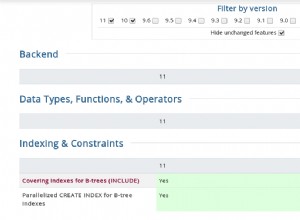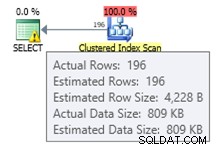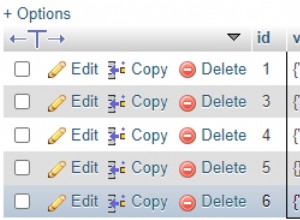Twoje wymagania nie są do końca jasne, ale wygląda na to, że próbujesz utworzyć nową kolumnę o nazwie c z następnie row_number() powiązane z nim -- c1, c2 c3, etc .
Jeśli w podzapytaniu użyjesz następujących informacji:
SELECT Val1, Val2,
'C'+ cast(row_number() over(partition by Val2
order by val1) as varchar(10)) col
FROM TEMP1
Zobacz SQL Fiddle z wersją demonstracyjną
Otrzymasz wynik:
| VAL1 | VAL2 | COL |
----------------------
| S01 | 00731 | C1 |
| S02 | 00731 | C2 |
| S03 | 00731 | C3 |
| S04 | 00731 | C4 |
| S05 | 00731 | C5 |
| S06 | 00731 | C6 |
| S07 | 00731 | C7 |
| S07 | 00731 | C8 |
| S08 | 00731 | C9 |
| S09 | 00731 | C10 |
| S04 | 00741 | C1 |
| S01 | 00746 | C1 |
| S01 | 00770 | C1 |
| S01 | 00771 | C1 |
| S02 | 00771 | C2 |
Co wydaje się być wynikiem, który chcesz następnie PIVOT . Następnie zastosujesz PIVOT do tego za pomocą:
SELECT Val2,
c1, c2, c3, c4, c5, c6, c7, c8, c9, c10
FROM
(
SELECT Val1, Val2,
'C'+ cast(row_number() over(partition by Val2
order by val1) as varchar(10)) col
FROM TEMP1
) src
PIVOT
(
MAX(Val1)
FOR col IN (C1, C2, C3, C4, C5, C6, C7, C8, C9, C10)
) piv;
Zobacz Skrzypce SQL z wersją demonstracyjną . Twój końcowy wynik to wtedy:
| VAL2 | C1 | C2 | C3 | C4 | C5 | C6 | C7 | C8 | C9 | C10 |
------------------------------------------------------------------------------------------------
| 00731 | S01 | S02 | S03 | S04 | S05 | S06 | S07 | S07 | S08 | S09 |
| 00741 | S04 | (null) | (null) | (null) | (null) | (null) | (null) | (null) | (null) | (null) |
| 00746 | S01 | (null) | (null) | (null) | (null) | (null) | (null) | (null) | (null) | (null) |
| 00770 | S01 | (null) | (null) | (null) | (null) | (null) | (null) | (null) | (null) | (null) |
| 00771 | S01 | S02 | (null) | (null) | (null) | (null) | (null) | (null) | (null) | (null) |
Uwaga:moje wyniki różnią się nieco od żądanych wyników, ponieważ wykonuję ORDER BY val1 co powoduje S07 wartości do zgrupowania.
Nie ma kolejności danych w bazie danych, chyba że o to poprosisz, więc nie ma gwarancji, że jeden z S07 wartości pojawią się jako C10 . Aby uzyskać wynik, możesz użyć następujących elementów, ale nie ma gwarancji że wynik będzie zawsze w prawidłowej kolejności:
SELECT Val2,
c1, c2, c3, c4, c5, c6, c7, c8, c9, c10
FROM
(
SELECT Val1, Val2,
'C'+ cast(row_number() over(partition by Val2
order by (select 1)) as varchar(10)) col
FROM TEMP1
) src
PIVOT
(
MAX(Val1)
FOR col IN (C1, C2, C3, C4, C5, C6, C7, C8, C9, C10)
) piv;
Zobacz Skrzypce SQL z wersją demonstracyjną
. Używając order by (select 1) zmienia kolejność danych, ale nie gwarantuje, że zawsze będą w tej kolejności. Wynik:
| VAL2 | C1 | C2 | C3 | C4 | C5 | C6 | C7 | C8 | C9 | C10 |
------------------------------------------------------------------------------------------------
| 00731 | S01 | S02 | S03 | S04 | S05 | S06 | S07 | S08 | S09 | S07 |
| 00741 | S04 | (null) | (null) | (null) | (null) | (null) | (null) | (null) | (null) | (null) |
| 00746 | S01 | (null) | (null) | (null) | (null) | (null) | (null) | (null) | (null) | (null) |
| 00770 | S01 | (null) | (null) | (null) | (null) | (null) | (null) | (null) | (null) | (null) |
| 00771 | S01 | S02 | (null) | (null) | (null) | (null) | (null) | (null) | (null) | (null) |




